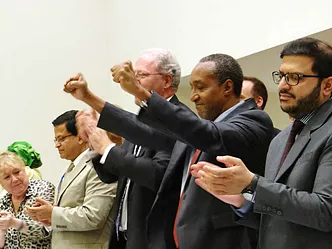
Final SDGs text, likely to be adopted in full at September summit, seen as bolstering local authorities.
A marathon weekend negotiating session reached the finish line on Sunday as 193 U. N. member states reached consensus on the outcome document of the Sustainable Development Goals (SDGs), the framework that will now guide global efforts to combat poverty and promote sustainable development for the next decade and a half.
The culmination of this years-long process resulted in several important gains for supporters of a standalone goal on cities — the landmark Goal 11, known as the urban SDG, offering the first-ever international agreement on urban-specific development.
“It is fascinating to witness how for the first time in history all countries on this Planet Earth are trying to collectively agree and own a universal human development agenda,” said Maruxa Cardama, executive director of the Communitas Coalition, which has advocated strongly for the urban SDG. “The targets and tools for improving livelihoods and the protection of the planet in a horizon of 15 years are simply unprecedented and empowering at a global scale. The best news: We can’t wait to start implementing it!”
The outcome document, “Transforming Our World: The 2030 Agenda for Sustainable Development”, is now expected to be adopted by heads of state and government without changes at the Special Summit on Sustainable Development, taking place 25-27 September at U. N. Headquarters in New York.
“This is the people’s agenda, a plan of action for ending poverty in all its dimensions, irreversibly, everywhere, and leaving no one behind,” said U. N. Secretary-General Ban Ki-moon. In a written statement, U. S. Secretary of State John Kerry said, “The close of negotiations marks a pivotal moment of international consensus on a common vision for our planet’s future.”
Cities were virtually guaranteed a prominent place in the final outcome document by dint of Goal 11, which calls for sustainable, inclusive, safe and resilient cities and human settlements. Attempts to reduce the overall number of goals, which might have affected the urban SDG, were thwarted in earlier negotiations.
“From the perspective of humanity now being predominantly urban, the inclusion of Goal 11, the urban SDG, is profoundly important,” said David Simon, the director of Mistra Urban Futures, a foundation that has supported the push for an urban SDG, “as well as representing the first time that the U. N. has adopted an explicitly subnational focus and set of indicators.”
Policy coherence
Reaching the finish line over the weekend hinged on language over issues other than cities and human settlements. Member states and coalitions wrangled over human rights, water, “common but differentiated responsibilities” between development and developing countries, climate change, gender inequality, reproductive rights and the means of implementing the new development agenda vis-à-vis the recently struck Addis Ababa Action Agenda.
As a result, “Transforming Our World” contains more than just a list of SDGs. The language in its preamble and declaration frame the implementation of the SDGs and set the stage for how they will interact with other U. N. processes.
The final preamble contains the same formulation as previous versions, that of the Five P’s: People, Planet, Prosperity, Peace and Partnership. However, while a previous version of the preamble had lumped cities and human settlements in the Planet category, the final version is far more condensed and does not make specific references to the keywords of individual goals.
As Citiscope previously reported, last week Ecuador proposed an amendment that would specifically recognize Habitat III, next year’s major cities summit, in a paragraph dedicated to the importance of urban areas. But its language was watered down in subsequent versions, eventually reading: “We look forward to the upcoming United Nations Conference on Housing and Sustainable Urban Development in Quito, Ecuador.”
“The focus should now shift to integrating this agenda into national planning frameworks and developing multi-stakeholder implementation partnerships. The upcoming Habitat III conference will provide a unique opportunity to gather urban actors and build on the Sustainable Development Goals to shape a better urban future.”
Raf Tuts, UN-Habitat
Even if less robust than hoped, the inclusion of this reference is being seen as a significant achievement, particularly in potentially helping to ensure that next year’s conference maintains the momentum being generated by the Post-2015 Development Agenda. The SDGs, particularly Goal 11, should now provide an important framework for the drafting of the New Urban Agenda, the 20-year urbanization strategy that will come out of Habitat III.
“We are especially excited by the passage of ‘Transforming Our World’ with its inclusion of Goal 11 on cities and human settlements and its important shout-out of the Habitat III conference in Paragraph 33,” Eugénie Birch, the chair of the World Urban Campaign and president of the General Assembly of Partners, said. “Global leaders have pointed the way for policy coherence among the range of consensus arrangements that are occurring and will continue to grow through 2016.”
UN-Habitat, the lead agency on the Habitat III process, lobbied strongly on behalf of the urban SDG and Habitat III’s inclusion in the outcome document. Raf Tuts, the agency’s head of urban planning and design, called the SDG agenda “a milestone in the history of the United Nations.” He has already begun looking ahead to implementation.
“The focus should now shift to integrating this agenda into national planning frameworks and developing multi-stakeholder implementation partnerships,” he said. “The upcoming Habitat III conference will provide a unique opportunity to gather urban actors and build on the Sustainable Development Goals to shape a better urban future.”
‘Groundbreaking’ subnational focus
Others are noting the increased voice that cities themselves are finding as a result of the Post-2015 process.
“We are all over the moon” about the urban SDG, said Peter Head, founder of the Ecological Sequestration Trust, a think tank. “2015 has been a good year for enabling cities to take a strong role in addressing global challenges.”
Indeed, the “Transforming Our World” agenda offered more than just references to Goal 11 and Habitat III. For instance, Paragraph 33 also speaks more generally about sustainable urban development. Its second line reads, “We will work with local authorities and communities to renew and plan our cities and human settlements so as to foster community cohesion and personal security and to stimulate innovation and employment.”
Aliye Celik, the U. N. representative of United Cities and Local Governments, a global network, calls this
commitment “groundbreaking.” She said, “Its openness to innovations to improve living conditions in urban areas might be a catalyst for the creation of useful and efficient technologies.”
Celik also points to Paragraph 45. In addition to recognizing the “essential role of national parliaments”, that section calls for governments “to work closely on implementation with regional and local authorities”. Paragraph 52 likewise lists “local authorities” among the central actors on the “journey” to 2030. Such references, she said, “indicate the great success of local authorities in showing their impact and role in the development process,” she said.
Acknowledging these mentions, Rodrigo Messias, from the Network of Regional Governments for Sustainable Development (nrg4SD), expressed his group’s enthusiasm for the outcome. He said the new draft marks a stark turnaround from when the Millennium Development Goals (MDGs) were agreed upon, in 2000. The SDGs will now replace that framework, which expires this year.
“Local authorities did not receive the necessary attention in the MDGs framework,” Messias said. “Accordingly, [Paragraph 52] sets an unprecedented opportunity, as indeed the varied competencies and capacities of subnational governments, in a broad range of topics, will be a unique enabler and key factor for the successful implementation of the SDGs and targets.”
Finally, the section on follow-up and review acknowledges the subnational level as an important basis for measuring progress on the SDGs. Still, Messias says the document should have specifically referred to “local authorities” in these paragraphs, as well.
The next fight
Even amidst the general jubilation and sense of accomplishment, some remain poised for what they see as the next fight — to ensure that the SDGs are not watered down.
“This is a welcome sign of progress, but at the same time demonstrates the extent of change still required to the U. N. system, since final authority still rests with politically driven negotiations among governmental delegations, during which many carefully constructed targets and indicators and their rationales and explanatory texts become diluted or expunged,” Mistra’s Simon said. (Mistra also supports Citiscope.)
Indeed, once the Special Summit for Sustainable Development concludes, attention will turn to the SDG indicators — key metrics by which international, national and subnational entities will be able to mark actual progress being made on the new goals. Those indicators — drafts of which will be released later this month but which won’t be finalized until next spring — still have many negotiations to go.




